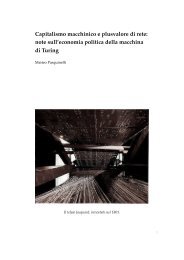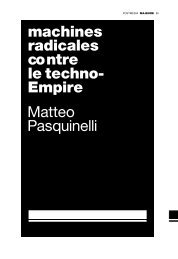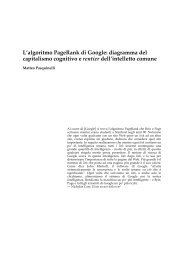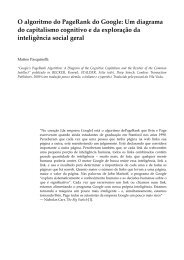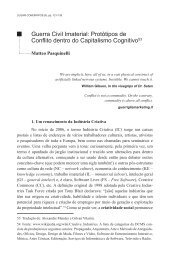Immaterial Civil War - Matteo Pasquinelli
Immaterial Civil War - Matteo Pasquinelli
Immaterial Civil War - Matteo Pasquinelli
Create successful ePaper yourself
Turn your PDF publications into a flip-book with our unique Google optimized e-Paper software.
The collective symbolic capital of Barcelona is shaped more clearly now. Thebrand of Barcelona is a “consensual hallucination” produced by many butexploited by few. The condition of the creative workers (and of the wholesociety) is a vicious circle: they produce symbolic value for the real estateeconomy that squeeze them (as they suffer the housing price of Barcelona).Furthermore, Harvey helps to understand better Florida: the so-called“creative class” is nothing but a simulacrum of the collective symbolic capitalto raise the marks of distinction of a given city. The “creative class” is thecollective symbolic capital transformed into an anthropomorphic brand and amonopoly rent applied to distinctive parts of the society (“creative class”), ofthe territory (“creative city”), of the city itself (“creative district”). The“creative class” is a parasitic simulacrum of the social creativity that isdetached from the precariat and attached to the upper class.The rise of Barcelona to prominence within the European system of cities hasin part been based on its steady amassing of symbolic capital and itsaccumulating marks of distinction. In this the excavation of a distinctivelyCatalan history and tradition, the marketing of its strong artisticaccomplishments and architectural heritage (Gaudi of course) and itsdistinctive marks of lifestyle and literary traditions, have loomed large, backedby a deluge of books, exhibitions, and cultural events that celebratedistinctiveness. […] This contradiction is marked by questions and resistance.Whose collective memory is to be celebrated here (the anarchists like theIcarians who played such an important role in Barcelona’s history, therepublicans who fought so fiercely against Franco, the Catalan nationalists,immigrants from Andalusia, or a long-time Franco ally like Samaranch)?Harvey tries to sketch out a political response questioning which parts ofsociety are exploiting symbolic capital and which kinds of collective memoryand imaginary are at stake. Symbolic capital is not unitary but a multiple spaceof forces, and can be continuously negotiate by the multitude that produced it.It is a matter of determining which segments of the population are to benefitmost from the collective symbolic capital to which everyone has, in their owndistinctive ways, contributed both now and in the past. Why let the monopolyrent attached to that symbolic capital be captured only by the multinationalsor by a small powerful segment of the local bourgeoisie? […] The struggle toaccumulate marks of distinction and collective symbolic capital in a highlycompetitive world is on. But this entrains in its wake all of the localizedquestions about whose collective memory, whose aesthetics, and who benefits.[…]. The question then arises as to how these cultural interventions canthemselves become a potent weapon of class struggle.The crucial question is: how to develop a symbolic capital of resistance thatcan not be exploited as another mark of distinction? As Harvey points thiskind of vicious circle works even better in the case of local resistance. Globalcapitals need anti-global resistance to improve the monopoly rent. Especiallyin the case of creative workers resistance is always well-educated and welldesigned:and in the case of Barcelona it produces a titillating and neverdangerous environment for the global middle-class. Inspired by the history ofBarcelona, we introduce an immaterial civil war into the space of symboliccapital.10



